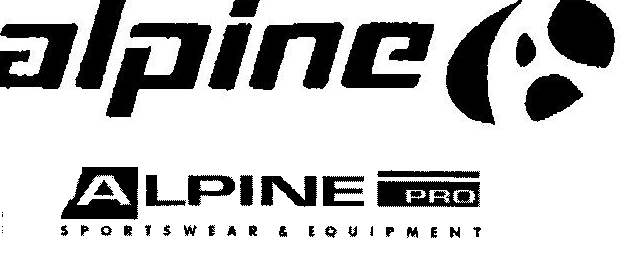Alpine refereert aan locatie van productgebruik
Gerecht EU 15 november 2011, zaak T-434/10 (Václav Hrbek tegen OHIM/The Outdoor Group Ltd)
 Gemeenschapsmerk. Oppositieprocedure op basis van ouder gemeenschapsbeeldmerk ALPINE tegen aanvrage gemeenschapsbeeldmerk ALPINE PRO SPORTSWEAR & EQUIPMENT. Geen bewijs waaruit misbruik van bevoegdheid door het OHIM. Relatieve weigeringsgrond: verwarringsgevaar. Volgens eiser refereert Alpine aan de locatie van productgebruik, tot dusver moet het eerste woord dus als beschrijvend worden gezien; dit beroep op absolute weigeringsgrond valt niet binnen de jurisdictie van het Gerecht EU in oppositie procedures. Een zwakke onderscheidend vermogen van ouder merk doet niets af aan het feit of er verwarringsgevaar is of overeenstemming tussen tekens en tussen goederen en diensten. Afwijzing van oppositie.
Gemeenschapsmerk. Oppositieprocedure op basis van ouder gemeenschapsbeeldmerk ALPINE tegen aanvrage gemeenschapsbeeldmerk ALPINE PRO SPORTSWEAR & EQUIPMENT. Geen bewijs waaruit misbruik van bevoegdheid door het OHIM. Relatieve weigeringsgrond: verwarringsgevaar. Volgens eiser refereert Alpine aan de locatie van productgebruik, tot dusver moet het eerste woord dus als beschrijvend worden gezien; dit beroep op absolute weigeringsgrond valt niet binnen de jurisdictie van het Gerecht EU in oppositie procedures. Een zwakke onderscheidend vermogen van ouder merk doet niets af aan het feit of er verwarringsgevaar is of overeenstemming tussen tekens en tussen goederen en diensten. Afwijzing van oppositie.
In citaten:
Misbruik van bevoegdheid 22 It must be borne in mind that the concept of misuse of power has a precisely defined scope in European Union law and refers to cases where an administrative authority has used its powers for a purpose other than that for which they were conferred on it. In that respect, the Court has consistently held that a decision may amount to a misuse of power only if it appears, on the basis of objective, relevant and consistent evidence, to have been taken for purposes other than those stated (Case T‑30/00 Henkel v OHIM (Image of a detergent product) [2001] ECR II‑2663, paragraph 70, Case T‑247/01 eCopy v OHIM (ECOPY) [2002] ECR II‑5301, paragraph 22).
23 In the present case, however, the applicant has not put forward any evidence to demonstrate that the Board of Appeal, by adopting the contested decision, was pursuing a purpose other than that of ascertaining whether the mark applied for complied with the conditions for registration prescribed by Regulation No 207/2009, as regards the existence of a relative ground for refusal. By his arguments, the applicant has merely relied on circumstances allowing him to challenge the legality of the contested decision.
Verwarringsgevaar 68. The applicant submits that the term ‘alpine’ will be understood as a clear reference to the place where the products may be used or where they emanate from and that it cannot therefore be a constituent element of a mark, in particular for skiwear, rucksacks and other similar products for ski sports. Thus, in so far as the word element is descriptive and, therefore, lacking distinctive character, it must be available for use by other traders.
69. In that regard, first of all, on the assumption that that argument could be understood as meaning that the mark applied for was contrary to the absolute grounds for refusal and may not be registered, it must be borne in mind that this does not fall within the jurisdiction of the General Court in opposition proceedings (see, to that effect, judgment of 15 October 2008 in Joined Cases T‑305/06 to T‑307/06 Air Products and Chemicals v OHIM – Messer Group (Ferromix, Inomix et Alumix), not published in the ECR, paragraph 62).
70. Secondly, should the applicant, by his submissions, be seeking to highlight the weak distinctive character of the earlier mark, it must be borne in mind that, in accordance with the case-law, the finding of a weak distinctive character for the earlier trade mark does not prevent a finding that there is a likelihood of confusion with the mark applied for. Although the distinctive character of the earlier mark must be taken into account when assessing the likelihood of confusion, it is only one factor among others involved in that assessment. Thus, even in a case involving an earlier mark of weak distinctive character, there may be a likelihood of confusion on account, in particular, of a similarity between the signs and between the goods or services covered (see PAGESJAUNES.COM, paragraph 70 and the case-law cited).


















































































